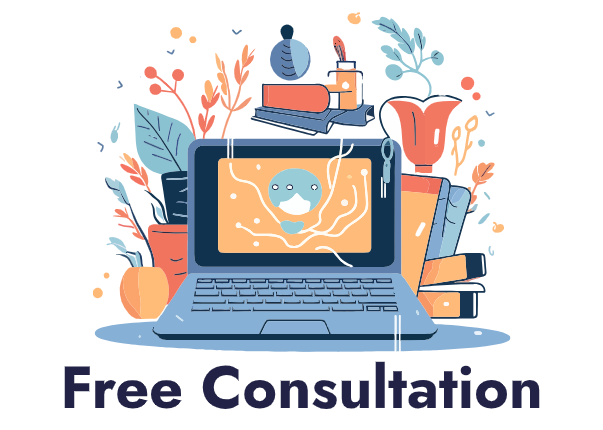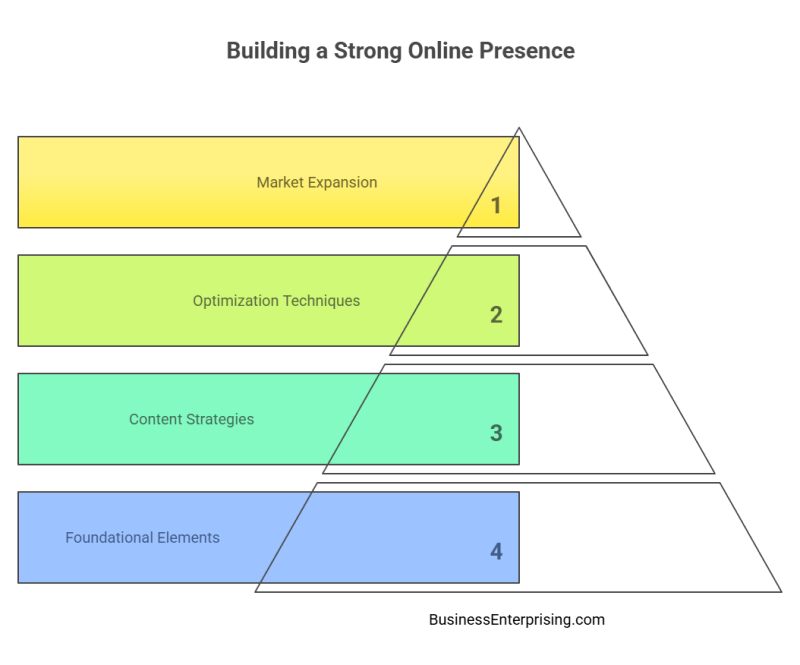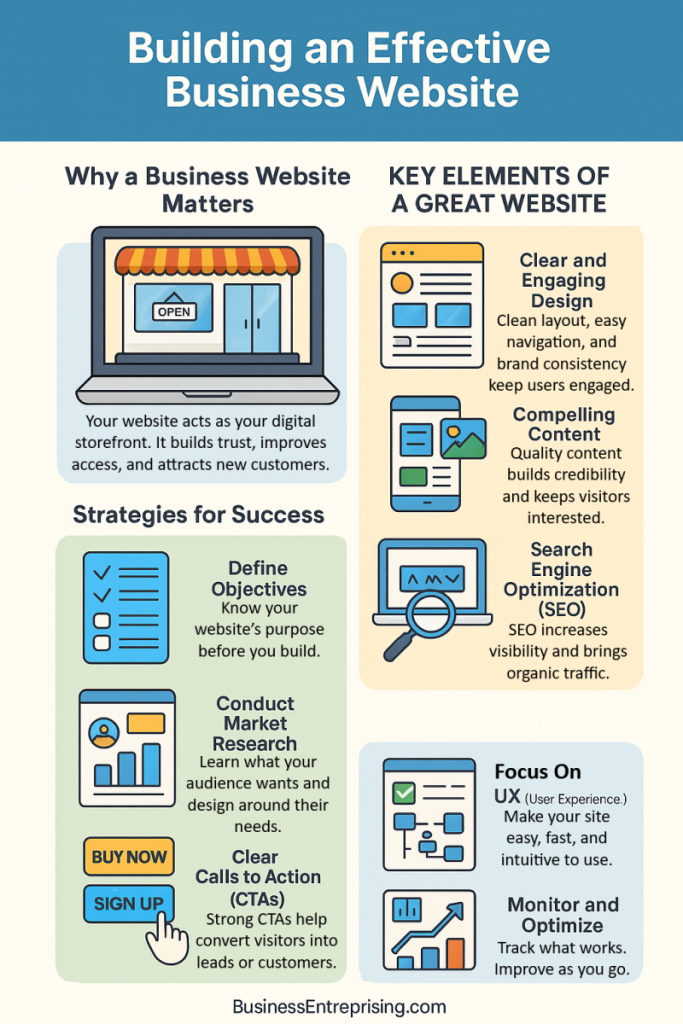Most customers look online before making a purchase or reaching out to a business. That’s why business websites matter more than ever. Your website is often the first impression people have of your company. If it looks outdated or confusing, you may lose trust before a conversation even begins.
Additionally, your website plays a major role in how people interact with your brand. It helps you share information, showcase your offerings, and guide visitors toward action. Whether you’re trying to build credibility or increase sales, your website is part of the process.
Moreover, business websites do more than display content. They connect to your marketing, social media, and customer communication efforts. Therefore, when set up well, they can work quietly in the background to support growth. A solid website also gives you more control over your message and branding.
You don’t need to be a tech expert to understand what makes a website effective. However, you do need to think about your goals, audience, and overall structure. By focusing on what really matters, you can create something that adds real value to your business.
Additionally, keeping your website up to date shows that your company is active and responsive. It helps people take your business seriously. The right layout, messaging, and functionality all work together to create trust and clarity.
If you’re building a new site or improving an existing one, starting with a clear strategy makes a big difference. Therefore, treat your website as a tool, not just a formality. Done well, it becomes one of your strongest business assets.
The Importance of Business Websites
Having a business website is no longer optional. It’s often the first place people go to learn about your company. Without one, you risk losing trust before you ever speak with a potential customer. Additionally, people expect businesses to have an online presence that looks professional and easy to use.
A website gives your business visibility around the clock. Customers can find you, learn about your services, and contact you at any time. Therefore, your website works even when your office is closed. This constant availability can help you reach more people and close more deals.
Moreover, business websites help build credibility. People tend to trust companies that look professional online. If your competitors have websites and you don’t, that gap may cost you business. Additionally, a well-designed site can help you stand out and explain what makes you different.
Your website also acts as a central hub. It connects your social media, email marketing, and ads all in one place. Therefore, you can use it to guide people toward specific actions like buying or signing up. Clear calls to action on your site help convert visitors into real customers.
Business websites don’t need to be complex. However, they do need to reflect your brand and meet customer expectations. A clean layout, strong messaging, and mobile-friendly design go a long way. Additionally, updating your content keeps your site relevant and engaging. If you treat your website like a key part of your business, it will pay off. It supports your marketing, helps grow your audience, and builds trust. That’s why having a strong online presence starts with your website.
Key Elements of a Business Website
Business websites need more than just a logo and a few pages. They require specific elements that help them work effectively. First impressions matter, so your design should be clean, clear, and easy to use. Visitors should understand what you offer within seconds of landing on your homepage.
Additionally, your content needs to be direct and helpful. Describe your services or products in simple terms. Use a tone that reflects your brand. High-quality text builds trust and gives visitors the confidence to take action. Including images and short videos can also keep users engaged.
Moreover, mobile responsiveness is no longer optional. Most people browse on their phones, so your site must work on all devices. A mobile-friendly design helps your site load quickly and look good everywhere. It also supports better rankings on search engines.
Search engine optimization helps your site get found. Therefore, use relevant keywords and write content people are actually searching for. Additionally, pay attention to your page titles and meta descriptions. These small things can make a big difference over time.
Clear calls to action are also important. Tell visitors what you want them to do next. Whether it’s calling you, filling out a form, or making a purchase, make the next step obvious. Good CTAs lead to more results with less effort.
Business websites perform best when they combine design, content, function, and strategy. Therefore, take time to review how yours is working. Adjust and improve it as your goals evolve. The right elements, in the right place, can help your website support your business every day.
Clear and Engaging Design
Firstly, the design of the website must be clear and engaging. A visually appealing design captures the visitor’s attention and encourages them to explore further. It is important to use a clean layout with easy navigation, ensuring that visitors can find the information they need quickly and effortlessly. Additionally, incorporating the company’s branding elements, such as logos, colors, and fonts, helps establish a cohesive brand identity.
Compelling Content
Secondly, compelling content is crucial. The website should provide valuable information about the business, its products or services, and its unique selling points. High-quality content, including blog posts, articles, and case studies, can demonstrate expertise and build trust with visitors. Furthermore, incorporating multimedia elements such as images, videos, and infographics can enhance the content’s appeal and engage visitors more effectively.
Mobile Responsiveness
Moreover, mobile responsiveness is essential. With the increasing use of smartphones and tablets, it is crucial that the website is optimized for mobile devices. A mobile-responsive design ensures that the website adapts to different screen sizes and provides a seamless user experience across all devices. This not only improves user satisfaction but also boosts search engine rankings, as search engines prioritize mobile-friendly websites.
Search Engine Optimization (SEO)
Additionally, search engine optimization (SEO) is a key consideration. SEO involves optimizing the website’s content and structure to improve its visibility on search engine results pages. This includes using relevant keywords, creating high-quality backlinks, and optimizing meta tags and descriptions. Effective SEO can drive organic traffic to the website, increasing its reach and attracting potential customers.
Call to Action (CTA)
Furthermore, incorporating clear and compelling calls to action (CTAs) is important. CTAs guide visitors towards desired actions, such as making a purchase, signing up for a newsletter, or contacting the business. Strategically placed CTAs can enhance user engagement and conversion rates. It is important to use persuasive language and design elements that draw attention to the CTAs.
Strategies for Building an Effective Business Website
Building an effective business website takes more than just good design. You need a plan that supports your goals from the start. First, define what you want your website to do. Do you want to drive sales, collect leads, or share information? Knowing the purpose will help shape the rest of your decisions.
Additionally, research your audience before you begin. Understanding what your customers expect allows you to meet their needs more directly. Use that knowledge to guide the layout, content, and functionality of your site. A user-focused design often leads to better results.
Moreover, work with a professional team if your budget allows. While DIY options exist, a custom-built site often delivers better quality. Developers and designers can create something that matches your brand and meets modern standards. This gives your business a more competitive look.
Furthermore, always think about the user experience. Simple navigation and fast-loading pages matter more than fancy effects. Your visitors should be able to find what they need quickly and without frustration. Good structure and clean design make that possible.
Lastly, review your site’s performance regularly. Use analytics to see how users interact with your pages. Test small changes to see what improves engagement. By making adjustments over time, you can keep the site effective as your business grows.
Building effective business websites require strategic planning and execution. Here are some key strategies to consider:
Define Clear Objectives
Firstly, defining clear objectives is essential. Understanding the purpose of the website and the goals it aims to achieve can guide the design and development process. Whether the objective is to generate leads, sell products, or provide information, having a clear focus ensures that the website serves its intended purpose effectively.
Conduct Market Research
Secondly, conducting market research can provide valuable insights into the target audience and their preferences. This information can inform the design, content, and functionality of the website. Understanding the needs and behaviors of the target audience ensures that the website is user-centric and meets their expectations.
Invest in Professional Design and Development
Moreover, investing in professional design and development is crucial. While there are many DIY website builders available, hiring experienced professionals can ensure a higher-quality website. Professional designers and developers can create a custom website that aligns with the business’s brand and objectives, providing a unique and competitive edge.
Focus on User Experience (UX)
Furthermore, focusing on user experience (UX) is key to creating an effective website. UX design involves understanding the user’s journey and designing the website to provide a seamless and enjoyable experience. This includes optimizing page load times, simplifying navigation, and ensuring that all elements are intuitive and user-friendly.
Monitor and Optimize
Lastly, continuous monitoring and optimization are essential. Regularly reviewing website analytics can provide insights into user behavior and identify areas for improvement. A/B testing different elements, such as CTAs or page layouts, can help determine what works best. Continuous optimization ensures that the website remains effective and aligned with changing user needs and market trends.
Conclusion
A well-planned website gives your business more than just an online presence. It supports growth, communication, and customer trust. Additionally, it helps people understand who you are and what you offer. If you design with purpose, you’ll create a site that works as hard as you do.
Moreover, business websites allow you to stay connected with your audience at all times. Your site can promote services, answer questions, and collect leads. Therefore, it acts as a full-time support tool for your operations.
Think of your website as an investment in your long-term success. It’s not just about having a place online. It’s about using that space effectively to support your business goals. Additionally, your site can grow and evolve alongside your company.
You don’t need to launch with every feature right away. However, starting with clear goals and simple design makes a big difference. From there, you can build on what works and improve the rest. Regular updates help keep content fresh and useful.
Therefore, take time to review your site’s structure, content, and functionality. Ask if it’s helping your business move forward. If not, small changes can lead to big improvements.
Business websites remain one of the most useful tools for building brand awareness and customer trust. When done well, your site becomes a reliable resource that adds value every day. Treat it as an active part of your business strategy and it will continue to deliver results.



